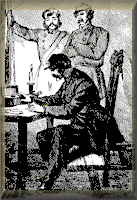USGenWeb Free Census Project Help, Various sources of the census records
We have received a number of questions about where to get the census record, and how to go about transcribing or proofreading it. The census record is available to you in several forms, listed in order of preference below.
- On rolls of microfilm
- On CD's for electronic images on your computer, copied from the microfilm
- On books of photocopy images copied from the microfilm
- On books published of previous transcriptions
Please note the following: For the most part only the first three options given above are acceptable for use as a transcribing or proofreading source, but you can refer to previously published transcriptions as a "triple-check" if you wish, in addition to our two levels of transcription using the preferred sources. Options 2 & 3 above may sound great, but unfortunately the quality of the copy is often very disappointing, and reference must still be made to the microfilm at times to decipher entries. In addition, CD's have not yet been produced (despite sales claims) for large areas of the country, particularly in the West.
Microfilm is the preferred and the usual source of census records for transcription in this project. Project rules since 1997 have required the use of microfilm for either the first or the second (i.e. proofreading) transcription, with it strongly recommended that ALL proofreading be done from microfilm. Since using microfilm is normally the least expensive method of doing our work as well as the most accurate, you can see why it is usually employed.
Microfilm reading equipment is available for public use free of charge at all Family History Centers and most medium size and larger public libraries. All branches of the National Archives and Records Administration (NARA) have numerous free public microfilm readers. All college and university libraries have microfilm reading equipment, most are open free to the public. State Archives and State Libraries have film facilities open free to the public. Many private libraries and historical or genealogical societies also have this available. Nearly every location with film reading equipment also has facilities to photocopy from microfilm.
The census films themselves can be found already on the shelf at NARA, State Libraries and Archives, large Family History Centers and large public and private libraries. All of the rest with microfilm reading equipment can quickly and easily order the film in at no charge or for the cost of postage, about three and a half dollars maximum.
The usual way of transcribing from microfilm is to write entries out on paper while viewing the film, then enter into the computer later at home. A variation on this is to photocopy from the microfilm at the library, then enter at home, but you must take special care to double check hard to read entries. Some people bring their laptop to the library and enter the data as they view the film, but this does not really work as well as it sounds.


